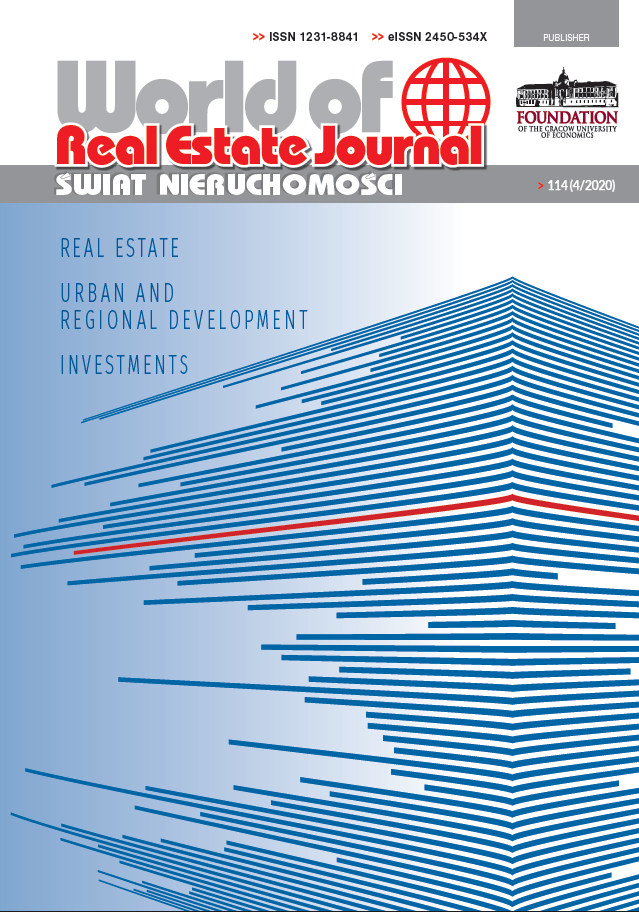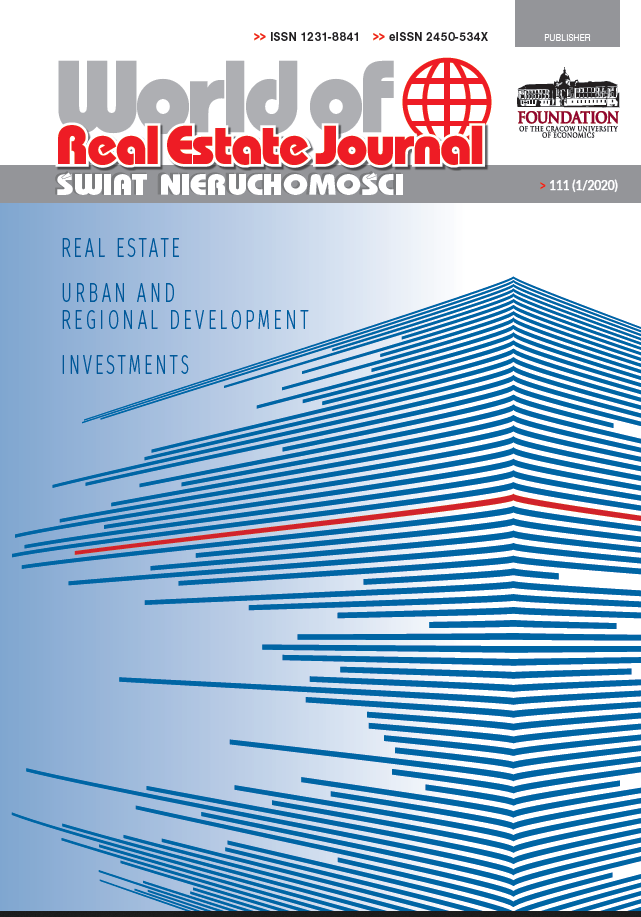1) Justyna Brzezicka, Marta Gross, Katarzyna Kobylińska - The Applicability of the Gini Coefficient for Analyses of Real Estate Prices DOWNLOAD
2) Mateusz Szczepek - Causes of Mortgage Loan Prepayment DOWNLOAD
3) Katarzyna Olbińska - Urban Regeneration – a Financial and Material Approach. The Scale of Financial Needs in Regeneration Processes Based on the Example of Selected Cities in Poland DOWNLOAD
4) Maciej Nowak, Desmond Gagakuma, Małgorzata Blaszke - Spatial Management Systems in Ghana and Poland — Comparison of Solutions and Key Problems DOWNLOAD
5) Paweł Niedziółka - Tightness of Financial Covenants Embedded in Corporate Bonds Issued by Real Estate Companies in Poland DOWNLOAD
SUMMARIES
Justyna Brzezicka, Marta Gross, Katarzyna Kobylińska - The Applicability of the Gini Coefficient for Analyses of Real Estate Prices
Purpose: This article discusses the selection of outlying transactions for the purpose of developing a database for analyses of real estate prices. The study aimed to determine the applicability of the Gini coefficient as an auxiliary tool for evaluating the distribution of real estate prices.
Method: Changes in the values of the Gini coefficient were analyzed in databases that were gradually reduced by extreme values. The primary database was composed of real estate prices in three districts of Warsaw in 2017-2018.
Findings: The results were also collated with other variability indicators and measures of location, asymmetry and skewness. The study demonstrated that the Gini coefficient produces similar results to a simple coefficient of variation, but is less sensitive to price changes.
Research implications: The main research limitation was a small database covering a single location; therefore, the article could be regarded as a case study. The study demonstrated that the Gini coefficient can be applied as an auxiliary tool in assessments of price dispersion on the real estate market.
Keywords: Gini coefficient; coefficient of variation; lorenz curve; real estate marker analyses
JEL codes: C10; C46; R21
Article type: case study
CITATION (APA): Brzezicka, J., Gross, M., Kobylińska, K. (2020). The Applicability of the Gini Coefficient for Analyses of Real Estate Prices. World of Real Estate Journal, 111(1), 4-15.
Mateusz Szczepek - Causes of Mortgage Loan Prepayment
Purpose: The default was always found as the main risk that the banks face, as it mainly appears when the interest rates rise. On the other hand, when the interest rates fall, the borrowers may pay off their mortgages earlier. Prepayment behavior has been studied in the US since the early 70s, the article aims to present the development of mortgage risk management and to indicate the change of its assessment in Poland.
Method: A systematic review of the literature and an analysis of the real estate market in the US were used to distinguish the most common reasons for prepayment origination.
Findings: The study indicates four reasons for prepayment origination. The borrower’s incentives to prepay are distinguished by the ones caused either by the borrower or market situation. Each of those four reasons indicates situations they occur and presents some standards of its measurements. The study presents difficulties with the measurement of prepayment risk and suggests the areas of focus.
Research implications: The risk assessment during the mortgage approval process in Polish banks should include the prepayment risk to limit its scope rather than imposing prepayment penalties.
Keywords: mortgage; prepayment; risk; real estate; banking
JEL codes: G21; G51; R31
Article type: review article
CITATION (APA): Szczepek, M. (2020). Causes of Mortgage Loan Prepayment. World of Real Estate Journal, 111(1), 16-32.
Katarzyna Olbińska - Urban Regeneration – a Financial and Material Approach. The Scale of Financial Needs in Regeneration Processes Based on the Example of Selected Cities in Poland
Purpose: The research problem presented in the paper concerns the scale of regeneration needs in the largest cities in Poland. The aim of the conducted research was an attempt to identify the extent of these needs as well as to review and compare the scale of planned urban regeneration projects in financial and material quantitative) terms.
Method: The research area represents the eleven largest cities in Poland in terms of population. The time frame covers current urban regeneration programmes created since 2015, enacted or updated by the end of August 2019. To achieve the objectives of the study, the following methods of data collection were used: a literature review, desk research and, the free-format interview. For data analysis, desk research and comparative analysis methods were used.
Findings: The total value of the projects planned in the eleven studied cities exceeded PLN 14 billion. The value of regeneration needs in Polish cities was estimated at PLN 50.7 billion. The intensity of activities planned in the cities surveyed in the years 2015-2020+ is more than three times higher than that planned in the largest cities (more than 200,000 inhabitants) in the 2007-2013 financial framework. However, the scale of the intervention may still be insufficient. At the same time, the scope of planned actions may exceed the real financial capacity of some cities, resulting in the partial implementation of the urban regeneration process and the achievement of only fragmentary changes described as islands of renewal.
Research implications: The analyses carried out show a clear relationship between the availability of EU funds and the scale of planned regeneration activities, as well as the dominance of investment activities in most of the studied cities. Furthermore, it can be said that the problem identified in previous programming periods, i.e. covering with programmes too large urban areas, has not been resolved.
Keywords: urban regeneration; regeneration costs; regeneration scale; regeneration programming, EU funding.
JEL codes: R510, R580, R530
Article type: research article
CITATION (APA): Olbińska, K. (2020). Urban Regeneration – a Financial and Material Approach. The Scale of Financial Needs in Regeneration Processes Based on the Example of Selected Cities in Poland. World of Real Estate Journal, 111(1), 16-32.
Maciej Nowak, Desmond Gagakuma, Małgorzata Blaszke - Spatial Management Systems in Ghana and Poland — Comparison of Solutions and Key Problems
Purpose: The aim of the paper is to compare solutions and key problems occurring in spatial management systems in Ghana and Poland.
Method: Based on the literature on the subject, the structure of the spatial management systems in Ghana and Poland was compared in detail, along with related problems.
Findings: While in both countries, diverse social phenomena somewhat differently determine the way the cities and suburban areas are developed, in both cases, spatial chaos contributes to the generation of costs related to environmental pollution, transport difficulties and social exclusion. Based on the analyzes carried out, it can be indicated that in Poland and in Ghana it is particularly important to block uncontrolled urbanization and wider integration of development policies.
Research limitations: A comprehensive analysis of all conditions of a given spatial development system includes a huge interdisciplinary discourse (conducted in both countries). It should be pointed out that among the key problems are issues of land development around large cities.
Research implications: An important postulate is to conduct regular consultations of expert groups from both countries, combined with the verification of subsequent activities and the directions of changes presented in detail.
Keywords: System of spatial management; tools of spatial policy; problems in spatial policy; suburbanization
JEL codes: R58
Article type: review article
CITATION (APA): Nowak, M. J., Gagakuma, D., Blaszke, M. (2020). Spatial Management Systems in Ghana and Poland — Comparison of Solutions and Key Problems. World of Real Estate Journal, 111(1), 59-77.
Paweł Niedziółka - Tightness of Financial Covenants Embedded in Corporate Bonds Issued by Real Estate Companies in Poland
Purpose: Analysis of the debt potential of real estate companies and answering the question how restrictive the covenants in question are and which factors influence their restrictiveness.
Method: Verification of the correlation between Headroom Ratio and variables describing the issuer's financial situation, type of activity and number of covenants. The study covered also the determination of types of issuers that have the highest average and median of Headroom Ratio as well as in relation to companies with the same covenants it was checked the association between the threshold values and the financial performance. Finally, there was carried out the simulation of usage of ratios typical for corporate financing as covenants and confronting the Headroom Ratios with ones resulting from the currently binding covenants.
Findings: Headroom for the analysed bond issue programmes is very high. The Headroom Ratio is neither statistically correlated with the financial performance of issuer nor type of activity.
Research limitations: Bond issuers under review do not have external ratings, which made it impossible to investigate the relationship between Headroom Ratio and rating
Research implications: The findings are particularly important for the development of the residential and commercial real estate market. The conclusions of the research can be used in the process of structuring the terms and conditions of corporate bond issues. They are also important and new information about leverage potential and risk monitoring capabilities.
Keywords: corporate bonds, financial covenants, Catalyst, real estate market
JEL codes: G23
Article type: research article
CITATION (APA): Niedziółka, P. (2020). Tightness of Financial Covenants Embedded in Corporate Bonds Issued by Real Estate Companies in Poland.
World of Real Estate Journal, 111(1), 78-97.
























































